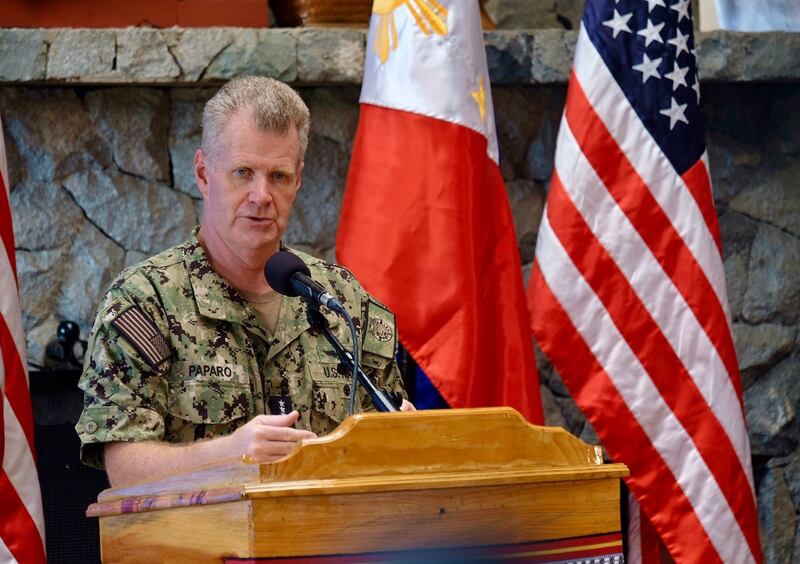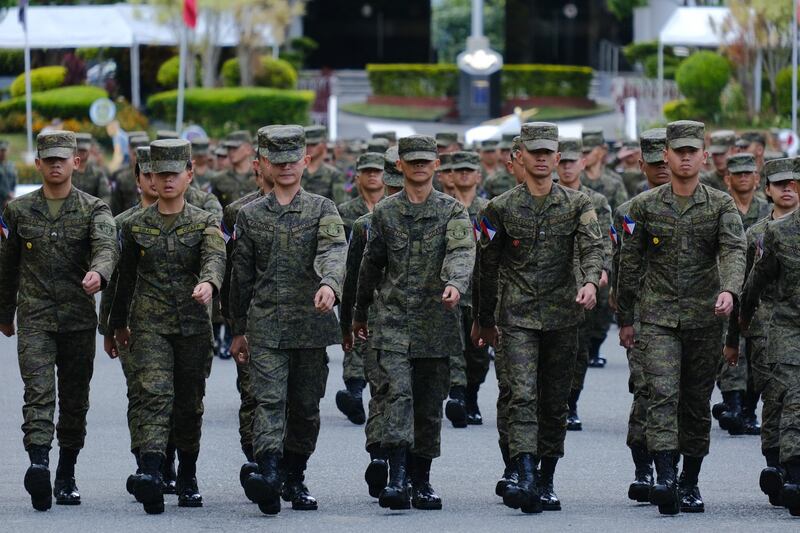The Philippine armed forces chief said Thursday they would "exhaust all options" before accepting a U.S. military offer for American ships to escort Manila's rotation and resupply missions to South China Sea waters.
Adm. Samuel Paparo, the head of the U.S. Indo-Pacific Command, reiterated the offer during a bilateral meeting the same day in the Philippine mountain city of Baguio. The talks took place in the wake of recent maritime and air confrontations between Manila and Beijing in the disputed waterway.
“We are happy that the United States has given us a lot of options, including that of joining or escorting us for the RoRe [rotation and resupply missions], but as I said earlier, we are going to do the missions unilaterally,” Filipino military commander Gen. Romeo Brawner Jr. told reporters at the annual bilateral review of the Mutual Defense Board-Security Engagement Board (MDB-SEB).
“We will depend on ourselves first and we will try to exhaust all the options first before asking for help.”
The 1951 Mutual Defense Treaty commits the two allies to help each other in times of attacks by a third party. The Pentagon previously said it was prepared to assist Manila if it invoked the treaty amid threats from other nations.
“If we exhaust all options and nothing works, that’s the time we can ask for help,” Brawner said.
When asked what scenarios could force Manila to ask for help, Brawner replied: “When our troops are already hungry, they don’t have any supplies anymore because our resupply mission had been blocked and that they are on the verge of dying, then that’s the time we are going to seek the help of the United States.”
Among measures that the Philippines is undertaking, the military is using a helicopter to air drop supplies to troops stationed at sea, Branwer said, although other military officials had pointed out that such an option was limited.

Washington’s options for Manila
Paparo said the U.S. had laid out a "broad range of options" for the Philippines to tap, if and when the Southeast Asian nation decided that it needed assistance. He did not elaborate on what those options were.
“We stand ready,” Paparo said, when asked about the possibility of escorting the Philippines when it conducts its RoRe missions in the South China Sea.
“It’s a matter of policy, post-consultation, and there’s a range of options that are available.”
The United States now has access to nine Philippine bases where the U.S. military has prepositioned supplies and in some cases, weapons, including a mid-range capable missile called the Typhon System, currently deployed in the northern island of Luzon.
In June, Washington also pledged a U.S. $500 million aid infusion to the Philippines to boost its defense systems amid the ongoing perceived threat from China.
While both Manila and Washington had already expanded the coverage of the MDT to include civilian vessels traveling in the South China Sea, defense analysts and officials said more needed to be done to be able to respond to China's "gray- zone tactics" in the waterway.
RELATED STORIES
[ Philippine defense chief calls China ‘biggest disruptor’ to regional peaceOpens in new window ]
[ Philippines joins US-led allies in multilateral maneuvers in South China SeaOpens in new window ]
[ Philippines, US and allies stage show of force in South China SeaOpens in new window ]
[ Two US senators urge concrete action to aid Manila in sea disputeOpens in new window ]
[ Troubled waters: The South China SeaOpens in new window ]
But as it stands, the treaty already fits that purpose, an analyst told BenarNews on Thursday.
“Whilst there is always a desire for a greater degree of specificity in documents of this nature, ambiguity can actually serve as a deterrent to China, because they won’t know exactly how and when such a treaty might be brought into force, or in the specific case of the U.S. and the Philippines what constitutes an ‘armed attack,’” said Jennifer Parker, a security analyst from the Australian University’s National Security College.
“The [treaty] is clearly a deterrent to some degree, as China has not escalated its aggression within the Philippines EEZ to an armed attack,” Parker said.
She pointed out that the document itself was not an actual deterrent but the “commitment” by both parties to act on it.
“It is the commitment followed up by clear signaling that if a certain threshold was crossed, the U.S. would assist the Philippines in responding. Continuing to undertake joint patrols and demonstrating the closeness of the relationship is key here,” she said.

Thursday's meeting served for the militaries of the defense allies to charter cooperative activities for the upcoming year. Already, Paparo said they were preparing for joint military drills, called " Balikatan" (shoulder-to-shoulder), for 2025, which could even be bigger than this year.
“Our work is not done. It’s a beginning, not a culmination. Today’s discussions were substantive. They were creative,” Brawner said.
“It was a true discussion. And now comes a time where we'll roll up our sleeves and we'll iterate from these discussions now.”
BenarNews is an RFA-affiliated online news organization.
